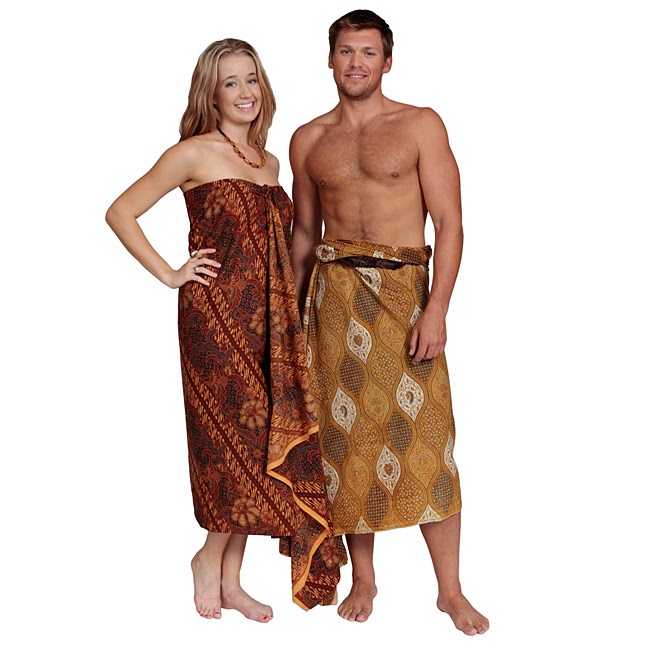We've once talked about our first choice of fabric being rayon sarongs. Next, we want to talk about the most popular traditionally used sarong
material – cotton fabric. Various cultures
in South East Asia used cotton sarongs also known as “Batik” for their traditional
women attire known as “kebaya”. The combination of a "kebaya" top and batik sarongs are historically worn by women in Indonesia, Malaysia, Brunei, Burma, Singapore, southern Thailand, Cambodia and the southern part of the Philippines.
 |
| Baba nyonya Kebaya traditional attire for women in Malaysia, Singapore, Brunei (Image via Pinterest) |
 |
| Kebaya style women seen in Bali culture (Image via Pinterest) |
..before that, what is Cotton? Cotton is a white, natural fiber cultivated from the seeds of cotton plants, they are made in threads and used to make soft, breathable-like textile when it comes to fashion.
 |
| Cotton plants (Image via agrodaily.com) |
If you’re a big fan of soft, fluffy and comfy wraps, then
cotton sarongs are perfect for you. And why
would you choose
cotton Sarong over other fabrics? Well, they make a great
beach wrap if you like the exotic look and makes an ideal wrap for windy days at the beach.
Batiks are handmade via batik stamp or hand stamp and so each batik sarong is a unique piece of its own! We feel that
it makes a great picnic mat too, its durable fabric makes it easy to lay out in
the sun and you can even get the whole family in because our traditional
sarongs comes in a larger size of (74 x 42 inches) compared to our
regular sarongs that are usually measured (66 x 44 inches).
If you like to think out of the box, try using your cotton sarong for home ware such as curtain drapes, table cloth cover, bed throw and so much
more. Have you ever thought about using your cotton sarong at home? That aside, we always feel that
sarongs make a great travel companion because they are so reliable in all
situations. We think that cotton sarongs would work great as your temporary travel bed sheet
(soft on your skin!), a portable blanket (nice, thick and warm!) and a towel (the
fabric absorbs water very well!).
Not to mention, cotton sarongs can be worn and used for all seasons –
be it spring, summer, fall or winter! Some of customers use their cotton
sarongs to wrap up their necks, head or shoulders for the cold season. Some
even take it with them on date night at the movies when it gets chilly with air
conditioning. Cotton is thick and solid enough to keep you warm than say
polyester or rayon fabric.
By the way, have you ever wondered where does Cotton grow? Cotton is usually harvested in warm climates and some of the main producers in the world are countries like the U.S., Uzbekistan, China , India, Brazil, Pakistan and Turkey.
 |
| Image via thehindu.com |
Fun Facts about Cotton:
- Absorbs up to 27 times its own weight in water
- Has a comfortable, soft hand
- Easy to wash
- Is durable and strong
- Conducts heat well
- Resists graze & chemicals impacts
- Resists pilling and moths
- Easy to handle and sew
How to care for your cotton sarong?
- Do not overexpose your cotton sarong under the sun for longer durability.
- Due to its low resiliency, after a quick wash, avoid squeezing it dry for fewer wrinkles on fabric.
- Keep your cotton sarong washed with the same color clothing to avoid color spill over.
- Do not use hot water, stick to cold wash
We also got a cool tip to share,
how can you tell if our sarong is made of cotton or other fabric?Scrape the fabric with your finger nail and if the
threads separate, then the fabric that you have might be low grade cotton or
mixed material because good cotton sarongs won’t separate that easily.
In a nutshell, why do we use more of rayon sarongs than
cotton fabric? Well, cotton as sarongs doesn't really drape as well as rayon and
they are higher in cost and since we try to run our business with sustainable practices, we want to be efficient and would rather produce more with rayon material than cotton. While cotton can be more durable and gives
a feeling of breath-ability but in our experience, rayon seems to flow better on
a body and have more breath-ability which makes it great for the tropical
weather. Plus, it's allows us to offer you fair prices and good quality sarongs at the same time, which is why it’s our primary choice of
sarong fabric. That doesn't mean we don't ADORE our cozy cotton sarongs though!
Up next, we’ll be talking about polyester sarongs in Part 3. Stay tuned and if you have any questions or feedback that might help us in our research, please leave us a comment below:
Peace & Love,
The 1 World Family





























.jpg)







